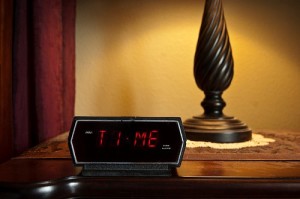It’s almost that time of the year—time to set the clocks back an hour on Sunday, November 2nd at 2 a.m. While for many the “fall back” switch is easier than the “spring forward,” it can still take days before your body’s internal clock adjusts to the time change. Here are a few ways to prepare your schedule, your body, and your apartment to make sure the switch goes as smoothly as possible.
Start Early
If you’re nervous about how you’ll be able to adjust your sleep schedule, start gradually staying up a little later than you normally would each night leading up to the time change. That way when the clocks roll backward, you’ll feel sleepy right at your normal bedtime, putting you a step ahead of the game for the workweek on Monday.
Consider When to Change Your Clocks

Image © Photo Extremist
Most people change their clocks before they go to bed on the night of the change. That means that if you set your morning alarm for your normal time, you’ll be getting an extra hour of sleep. While this is nice for some, that extra hour could potentially have a negative effect on your consistent sleep schedule. If you wait to change your clocks until the next morning, you will be getting your normal amount of sleep. Waking up at your normal time and resisting the urge to use that extra hour for sleeping will help your body adjust to the time change.
Make Light Your Friend
Many dread the “fall back” time change in November, as the days feel shortened by the earlier sunsets. It helps to keep in mind that there will be more light in the early morning hours. Sunlight helps you wake up naturally, so consider leaving the blinds open in your apartment to reap the benefits. In the same vein, if you resist sleeping in an extra hour on the 2nd, you can seize the day and use that hour for a beautiful fall morning hike.
Pay Extra Attention to Exercise and Diet
Your diet and exercise can do wonders for getting a good night’s sleep. In the days leading up to the daylight savings time change, make sure you’re getting your blood moving with a daily workout. Eating healthy foods will also help prepare your body for the switch. Additionally, you may even consider cutting out caffeine or alcohol from your diet, as these known sleep disruptors can make the adjustment that much harder for your internal clock.
Have a Sleep Routine

Image © Habitat Apartments
Creating a relaxing routine leading up to bedtime can assure you a better sleep. When it’s time to wind down, put down the electronics and turn off the television at least an hour before bedtime. The light emitted from these electronic devices can make it harder to fall asleep. Taking a warm bath, drinking a warm cup of tea, and dimming the lights in your apartment are all good ways to get your body prepared for sleep. Also, be sure that your bedroom in your apartment is a relaxing environment for your nightly rest. Reducing clutter in this space is a good idea, as is using relaxing colors to help naturally calm your body.
While the “fall back” time change does give us an extra hour in the day, that hour can derail your normal sleep rhythms if you’re not careful. These small tweaks will help keep that extra hour from sabotaging your schedule. Follow these tips and you should have an easy time with the daylight savings time transition.

